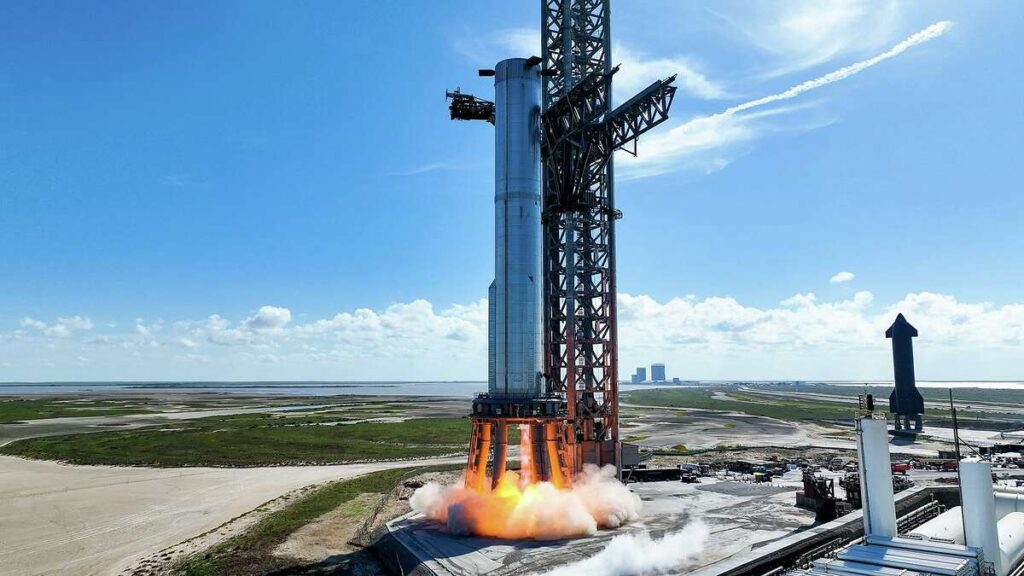SpaceX Super Heavy Booster
Specifications
- Function: Super Heavy Booster
- First stage for SpaceX Starship
- Height: 70 m (230 ft)
- Diameter: 9 m (30 ft)
- Propellant mass: 3,400 t (7,500,000 lb)
- Powered by: 33x Raptor engines. 33 in the outer ring (fixed) and 13 central (tilting).
- Maximum thrust: 72 MN (16,000,000 lbf)
- Propellant: Liquid oxygen, Liquid methane
- Second stage is: SpaceX Starship HLS
- Remarks: Can land on Earth
- Challenges:
A super heavy-lift launch vehicle can lift to low Earth orbit more than 50 metric tons (110,000 lb) by United States (NASA) classification. It is the most capable launch vehicle classification by mass to orbit, succeeding the heavy-lift launch vehicle classification. Crewed lunar and interplanetary missions are often developed around these launch vehicles’ payload capacity.
Many early super heavy-lift launch vehicle concepts were made in the 1960s, such as the Sea Dragon. During the Space Race, the Saturn V and N1 were built by the United States. The next two decades saw multiple concepts were drawn out once again, most notably Shuttle-derived vehicles and Rus-M, but none would be built. In the 2010s, super heavy-lift launch vehicles received interest once again, leading to the launch of the Falcon Heavy and the development of the Space Launch System, Starship, Long March, and Yenisei rockets.
Raptor engines and first full stack flight of Starship (20-04-2023)
The Raptor engine is Spacex’s latest and most ambitious rocket engine design. It runs on liquid methane and liquid oxygen, making it both incredibly powerful and environmentally friendly. This beast of an engine generates 2200 kilonewtons of thrust while still managing to be more efficient than its predecessors, it’s these engines that are destined to carry humanity to Mars and beyond. With their incredible capabilities, it’s no wonder that expectations were high for the Raptor engines during the Starship launch. So what went wrong? (april 2023)
Combustion instability
As it turns out, the problem began when the engines experienced a combustion instability during the test. This instability caused uneven pressure distribution in the combustion chamber, leading to excessive. Vibrations and ultimately engine failure. Now, combustion instability is not a new phenomenon in rocket science. Throughout the years, engine designers have faced similar issues and managed to come up with innovative solutions. The trickiest part is that each engine design is unique, and so are the problems they face. To understand why the Raptor engines failed, we need to dive a little deeper into their inner workings.
Full flow staged combustion cycle (FFSC)
The Raptor engines use what’s called a full flow staged combustion cycle. This means that both the fuel and the oxidizer are partially burned in separate pre burners generating hot gas that powers the engines turbines. This innovative design is what makes the Raptor so efficient, but it also adds complexity which can lead to combustion instability. The main cause of this instability is believed to be related to the combustion process of the liquid methane and liquid oxygen. These propellants burn at a very high temperature, causing the pressure inside the combustion chamber to fluctuate rapidly. This is further exacerbated by the fact that the Raptor engines operate at very high pressures. Making them even more susceptible to these rapid fluctuations.
One possible solution is to modify the engines injector design. Injectors play a critical role in the combustion process as they mix the fuel and oxidizer together in the combustion chamber. By optimizing the injector design, SpaceX could ensure a more stable combustion process, reducing the chances of instability and engine failure.
Another approach could be to tweak the fuel and oxidizer mixture ratios. By altering the proportions of liquid methane and liquid oxygen, SpaceX might be able to find a more stable combustion process that minimizes pressure fluctuations inside the chamber. While these solutions may seem straightforward, it’s important to remember that rocket science is anything but simple. There’s a delicate balance to strike, as making changes to one part of the engine can have unintended consequences for other components.
Footnote
- Sources: Aerospace dashboard, SpaceX, funkystuff.org
- Outgoing: NASA
- Keywords:

